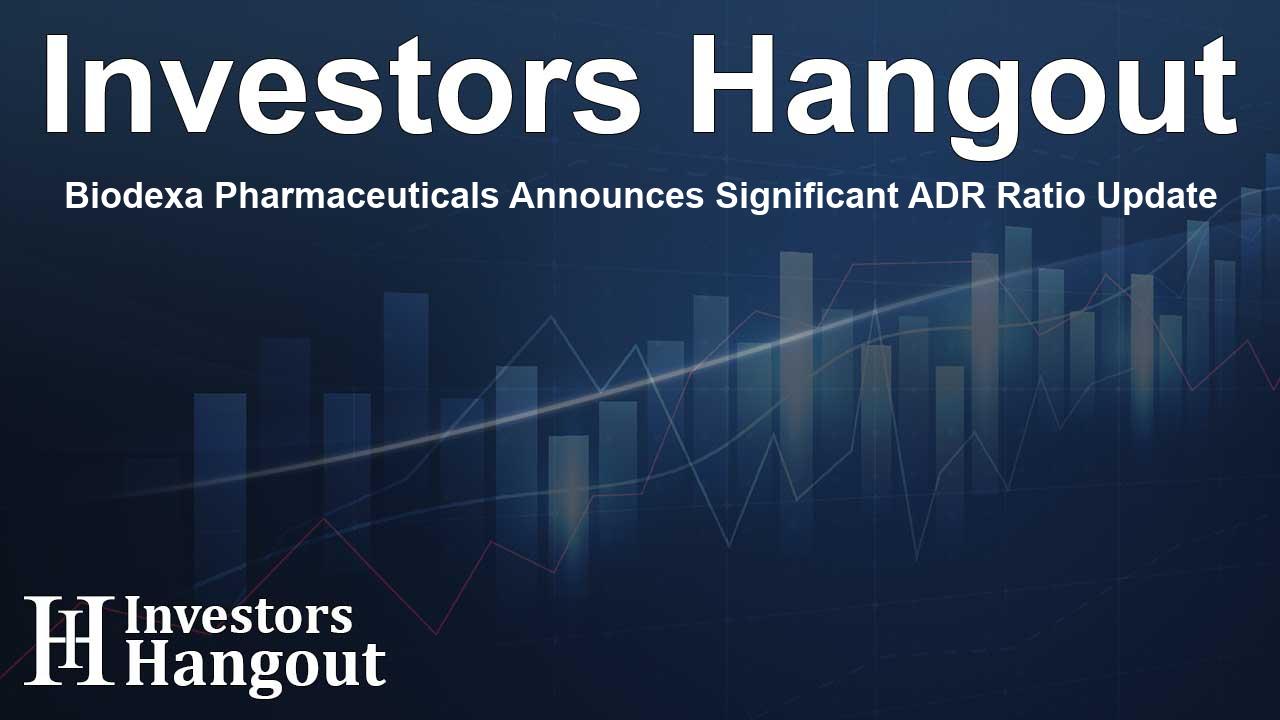Biodexa Pharmaceuticals Announces Significant ADR Ratio Update

Important Change in ADR Ratio for Biodexa Pharmaceuticals
Biodexa Pharmaceuticals PLC (Nasdaq: BDRX), an innovative clinical-stage biopharmaceutical company focused on developing products for unmet medical needs, has recently announced a notable change to its American Depositary Receipts (ADRs). This adjustment, effective soon, will transition from a current ratio where one ADR represents four hundred ordinary shares to a new ratio of one ADR representing ten thousand ordinary shares.
Understanding the ADR Ratio Change
This Ratio Change means that current ADR holders will need to surrender their existing ADRs to receive one new ADR for every twenty-five old ADRs they hold. This procedure will ensure that no fractional ADRs will be issued, and any aggregate fractions will be sold, distributing the net proceeds back to the respective holders. The Depositary Bank, JP Morgan Chase Bank, N.A., is set to handle these exchanges effectively.
What This Means for Stakeholders
The implications of the Ratio Change can be likened to a one-for-twenty-five reverse ADR split, an action that aims to adjust the pricing of Biodexa's ADRs to meet the Nasdaq minimum bid price requirement of $1.00. However, the Company acknowledges that there is no absolute guarantee the Ratio Change will achieve this aim.
Reasons Behind the Adjustment
This strategic move to alter the ADR ratio is part of Biodexa’s initiative to enhance its presence in the market and align with compliance requirements. By carefully managing their ADR structure, the company seeks to stabilize and potentially improve investor interest, which is crucial for its ongoing operations and future funding opportunities.
CEO Statement
Stephen Stamp, the CEO and CFO of Biodexa Pharmaceuticals, expressed that this transition is expected to bolster the appeal of their ADRs, ultimately benefiting shareholders as they navigate through the biopharmaceutical landscape.
Company Contact Information
For investors and ADR holders looking for more insights into this change or needing assistance, they can reach out directly to:
**Biodexa Pharmaceuticals PLC**
Tel: +44 (0)29 2048 0180
Website: www.biodexapharma.com
Frequently Asked Questions
What is the primary reason for the ADR ratio change?
The primary reason for changing the ADR ratio is to bring the price of Biodexa’s ADRs into compliance with the Nasdaq minimum bid price requirement.
How will the exchange process work for existing ADR holders?
Existing ADR holders need to surrender their old ADRs to receive new ADRs as part of the exchange process managed by JP Morgan Chase Bank, N.A.
When will the new ADR ratio take effect?
The effective date for the new ADR ratio is expected to be shortly after the announcement.
Will ordinary shares of Biodexa be affected by this change?
No, the ordinary shares of Biodexa will remain unaffected by the Ratio Change.
Where can I find more information about Biodexa Pharmaceuticals?
For additional details, you can visit the Biodexa Pharmaceuticals website or contact the company directly using the provided phone number.
About Investors Hangout
Investors Hangout is a leading online stock forum for financial discussion and learning, offering a wide range of free tools and resources. It draws in traders of all levels, who exchange market knowledge, investigate trading tactics, and keep an eye on industry developments in real time. Featuring financial articles, stock message boards, quotes, charts, company profiles, and live news updates. Through cooperative learning and a wealth of informational resources, it helps users from novices creating their first portfolios to experts honing their techniques. Join Investors Hangout today: https://investorshangout.com/
Disclaimer: The content of this article is solely for general informational purposes only; it does not represent legal, financial, or investment advice. Investors Hangout does not offer financial advice; the author is not a licensed financial advisor. Consult a qualified advisor before making any financial or investment decisions based on this article. The author's interpretation of publicly available data shapes the opinions presented here; as a result, they should not be taken as advice to purchase, sell, or hold any securities mentioned or any other investments. The author does not guarantee the accuracy, completeness, or timeliness of any material, providing it "as is." Information and market conditions may change; past performance is not indicative of future outcomes. If any of the material offered here is inaccurate, please contact us for corrections.